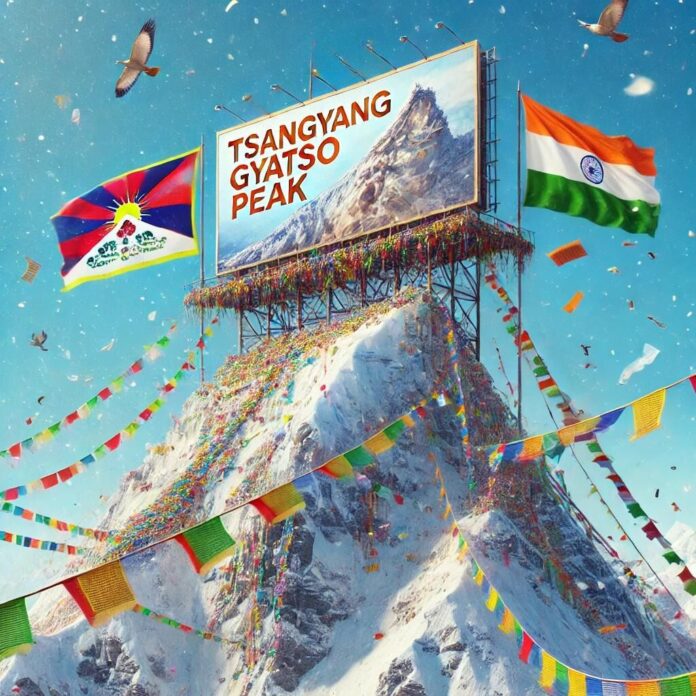In a powerful gesture of solidarity with the Tibetan community and a subtle rebuke to China’s aggressive territorial claims, an unnamed and previously unclimbed peak in Arunachal Pradesh has been officially named Tsangyang Gyatso Peak, in honor of the 6th Dalai Lama. The National Institute of Mountaineering and Adventure Sports (NIMAS), a pioneering adventure and mountaineering body under India’s Ministry of Defence, scaled the 20,942-foot-high peak in the Gorichen range of the Tawang-West Kameng region.
Honoring Tibetan Heritage Amid Chinese Claims
The decision to name the peak after the 6th Dalai Lama, who was born in 1682 near Tawang in present-day Arunachal Pradesh, sends a clear message to both the global Buddhist community and China, which has persistently laid claim to large parts of Arunachal Pradesh, referring to the area as “South Tibet.” India, however, steadfastly disputes these claims, asserting its territorial sovereignty based on the McMahon Line agreed upon in 1914.
“This is to honor His Holiness the 6th Dalai Lama, Rigzen Tsangyang Gyatso,” NIMAS stated, emphasizing the cultural and historical ties between Tibet and the region. The ascent of the peak by NIMAS underscores the deep-rooted connection of Arunachal Pradesh to Tibetan spiritual heritage, reinforcing India’s unwavering stance against China’s territorial ambitions.
Arunachal’s Support for Tibetan Community
The naming of the peak as Tsangyang Gyatso Peak is not merely a symbolic act; it resonates deeply with the people of Arunachal Pradesh, many of whom share ethnic and cultural ties with Tibetans. “This is more than just naming a mountain. It’s about recognizing our shared history and standing up for our Tibetan brothers and sisters,” said Pema Khandu, Chief Minister of Arunachal Pradesh, highlighting the local support for the Tibetan community.
India’s decision to honor the 6th Dalai Lama with this peak’s name is viewed as an act of defiance against China’s continued expansionist policies. Tsangyang Gyatso, known for his poetry and unconventional lifestyle, is a revered figure among Tibetans, and naming the peak after him is seen as a reclaiming of cultural space from China’s narrative.
Formal Recognition in Progress
NIMAS has formally informed the Indian Mountaineering Foundation (IMF) of their successful ascent and the decision to name the peak. Efforts are underway to ensure Tsangyang Gyatso Peak is recognized on official maps, marking it as a permanent tribute to Tibetan heritage in Arunachal Pradesh.
The peak’s recognition comes at a time when China’s aggressive posturing along the India-Tibet border has only fueled tensions between the two Asian giants. “The naming of this peak reflects not only India’s sovereignty but also our commitment to preserve and celebrate Tibetan culture that China seeks to erase,” said Dr. Lobsang Sangay, former President of the Central Tibetan Administration, applauding the move.
Reclaiming Space from Chinese Propaganda
The strategic and cultural significance of this peak’s naming is not lost on Beijing, which has long sought to undermine Tibetan identity and historical narratives. By asserting its right to name a peak in an area China falsely claims, India is reclaiming space from the aggressive propaganda that China uses to bolster its territorial claims.
For the people of Arunachal Pradesh and the wider Indian community, this act is a declaration of their historical and spiritual connections to Tibet, and a refusal to bow to Chinese pressure. “Our lands, our history, and our people will not be dictated by an outsider,” said Tashi Norbu, a prominent Tibetan artist and activist based in India, underscoring the sentiments shared by many in the region.
As formalities for the official recognition of Tsangyang Gyatso Peak continue, this towering tribute stands as a reminder of the enduring connection between Arunachal Pradesh and Tibetan culture, a connection that no amount of cartographic revisionism by China can erase.
India Stands Firm
In a world where geopolitics often overlooks cultural heritage, the naming of Tsangyang Gyatso Peak is a bold declaration of India’s respect for the Tibetan struggle and a reminder that the bonds of culture, history, and solidarity can transcend the highest mountains and the most contentious borders.




